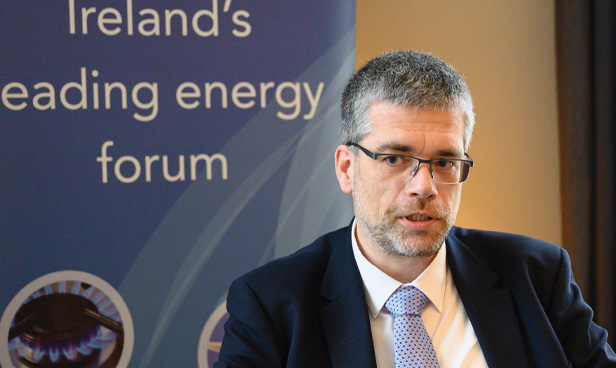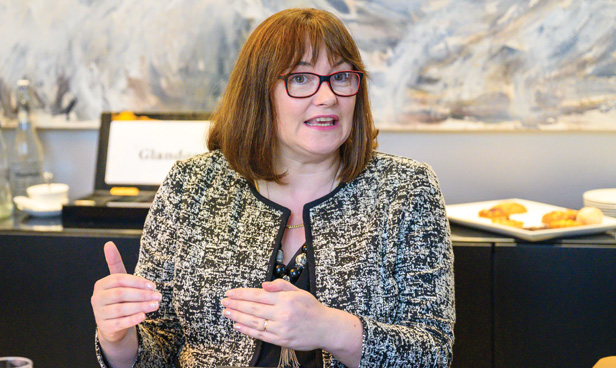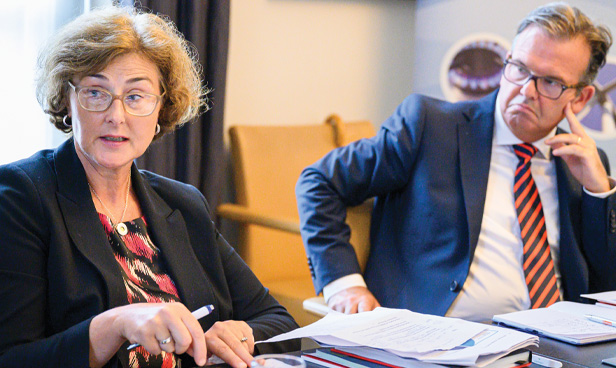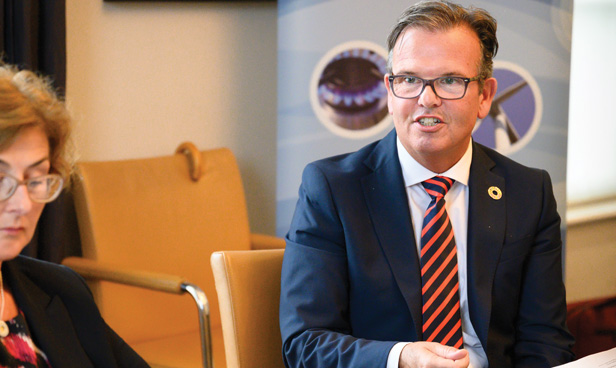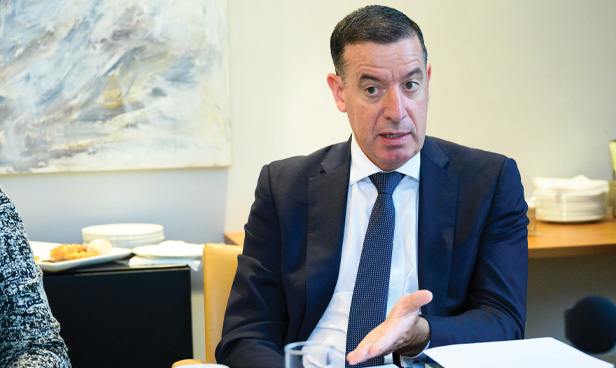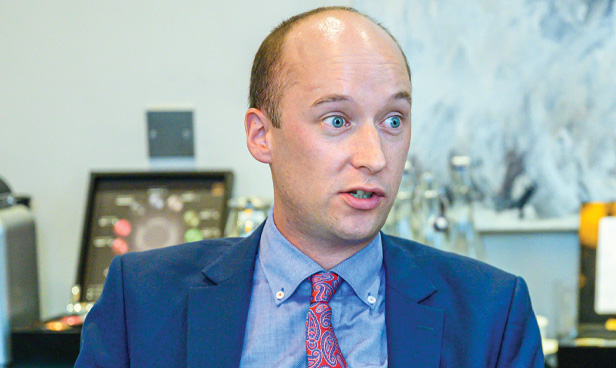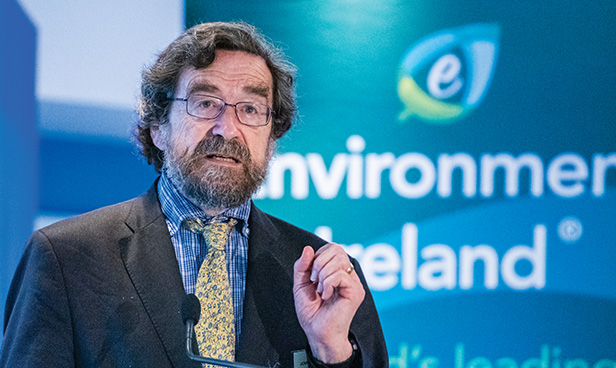
Decarbonisation: Barriers to progress
25th November 2019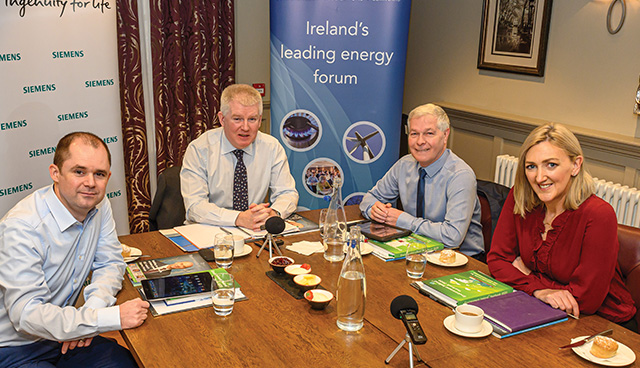
Road-mapping a zero-carbon future for the North West
25th November 2019Electric vehicles: vital for future mobility?

Gemserv hosted a round table discussion, bringing together the public and private sectors to discuss electric vehicles and the role they will play in combatting climate change and enabling future mobility.
What role will electric vehicles play in combatting climate change and contributing to better living?
Conor O’Brien
There are huge benefits associated with electric vehicles. The Irish car fleet averages about 140 grams of CO2 per kilometre travelled. Next year the target is for 40 per cent renewable electricity generation in Ireland and the target for 2030 is 70 per cent. So, there’s a real opportunity to use that cleaner energy to decarbonise transport.
The EPA recently rolled out more monitoring stations across the country and we’re getting a better picture of the nitrogen dioxide in our air. EVs and electric buses can help to improve air quality for citizens. The European Environmental Agency estimates that about 1,600 people die in Ireland each year because of poor air quality and it costs our economy about €2 billion each year. London has seen big improvements in their air quality in areas where bus fleets have been electrified or partly electrified.
Laura Behan
EVs are allowing us to be more energy efficient. They allow us to tap into the potential of renewable energy. I would also point to the air quality benefits, which we haven’t tended to focus on as much as other cities where the air quality is also poor. In urban areas, where you have congestion of ICE vehicles, the level of pollution that builds up is a real challenge that EVs will be part of the solution for. If we’re going to allow that number of vehicles in our cities, they’re going to have to be cleaner.
Declan Meally
In Ireland, our high potential for renewable electricity from wind puts us in a good position. On some weekends the system can be 100 per cent wind powered, on average we are well on track for 40 per cent by 2020. The private car is responsible for 80 to 90 per cent of transport emissions, making that more efficient and switching to renewable fuels is attacking a major chunk of transport emissions, which account for 25 per cent of national emissions. People could then relate turbines spinning in their area and powering their driving as they plug-in their car instead of fuelling it from imported fossil fuels.
“43 billion miles are driven every year in Ireland, that’s a lot of miles that need to be accounted for. We need to integrate all the technology out there for a seamless journey experience.” Joachim Brandt
Joachim Brandt
Climate change and air quality are almost too big as problems for the individual person to understand how it impacts them. From an energy system point of view, we’ve done well with the rise in renewable generation and so the next big ticket is transport. The temperamental nature of renewable generation requires large amount of storage to further increase for example deployment of wind generation and its utilisation. Significant geospatial distributed energy storage is embedded in the EV parc. This is where the disruption of EVs proves itself to be more than a car, it’s a car and energy and digital. We can unleash a whole raft of societal benefits with this fusion.
Helen Hughes
From a personal point of view, I do not particularly like refuelling my car at the petrol pump and I look forward to being able to charge it overnight. We have some air pollution hot points in the city so I’m looking forward to more electric buses and cars which will help improve air quality. Electric cars generate less noise at low speed, and I understand that manufactures will be obliged to increase the noise generated by EVs for safety reasons. At higher speeds there is no reduction in noise generated.
Dara Lynott
Private car ownership has gone up 8 per cent in the last 10 years, so if it goes up at that level over the next 10 years, are we welcoming those cars into Dublin every day? The number of miles driven is going up. People are spending more time in their cars, driving longer distances. I’m interested in what electric vehicle technology can do for public transport. It’s about reducing the number of vehicles in cities and linking with public transport. I walk to work every day and see electric scooters and skateboards being used by people getting off the Luas, so there’s innovation there. We also have to tackle the private bus transport system. The quality of how we live, particularly in cities, is dependent on the quality of our public transport.
What are the barriers to the uptake of EVs and how can we address them?
“The potential gains are enormous and tantalising in so many ways. Mobility as a service can make cities more liveable, eliminate the need for on-street parking, to properly facilitate public transport and other forms of mobility linked with digitisation. We can transform air quality and noise pollution in so many different ways.” Laura Behan
Laura Behan
We’ve studied well the reasons why people have been reluctant to take up EVs initially, although this is beginning to change in recent years. People can sometimes be afraid of disruption and the potential lifestyle changes that having an EV would bring. It is undoubtedly the case that the cost of buying a new EV was a barrier. In many places it was the availability of recharging infrastructure and anxiety from people over being able to finish their journeys. We’ve been trying to systematically address these barriers like most other governments around the world. Some have subsidised the cost to reduce the difference between EVs and traditional vehicles, there’s been huge investment in fuelling infrastructure. We had 900 charging points around Ireland seven years ago, but we acknowledge that that development didn’t keep pace with the technology and investment in new chargers. We recognise that the psychological change was such that the Government needed to provide an extra push, as we have seen with initiatives such as the tolling incentive and we’ve seen them pay off.
Conor O’Brien
There’s a lot being done in terms of incentives for the price of the car, but even when you look at the best performing EVs on the market, they’re still beyond most people. There’s the price and the choice, which are interlinked. There are 36 different car brands in Ireland providing 280 conventional vehicle models; nine of those 36 are providing 15 full electric battery powered passenger vehicles, so that’s 15 out of 280. There needs to be a range of vehicles out there that suits different lifestyles. I think the range concern is being met now, but you need the choice across car types so consumers can get what they’re looking for.
EVs are getting cheaper and better; in 2010, the Nissan Leaf was about €33,000 and had a 24kWh battery; the 40kWh version is about €30,000 now. The price is coming down and it will continue to come down as more cars come to market and battery prices decrease.
“It’s a totally inefficient use of production capacity and space to have people driving and parking up at train stations. What connected and autonomous allows us is to have a vehicle that would be 90 per cent of its time on the road bringing people to a train station.” Helen Hughes
Declan Meally
The original price is expensive, but when you look at the lifetime costs, it can be up to 80 per cent cheaper than running a petrol or diesel car. Servicing costs and incentives make an electric vehicle cheaper to own in the long-term and it’s about getting that information out there and this lower overall cost is something people are coming around to. We have seen exponential growth. We went from 2,500 to 5,000 to 10,000 EVs in the last three years.
Dara Lynott
Talking about behavioural economics, I don’t think that recent analysis that we will run out of the allocation EV incentives by 2021 has helped ease certainty or scarcity fears. Saying “we will have grants for a certain amount of time, get them while you can” would be more helpful. I think the supports are very important, particularly for home and work charging; 85 per cent of people charge in either of those places. We also need interoperability for travelling abroad. We need standardisation and consumer protection. There’s a lot of background work that needs to be done to instil confidence, but a bit of scarcity is no harm in terms of getting people to act fast.
Joachim Brandt
I am not as positive in this regard, because I think it’s fair to say that consumers here are sceptical and don’t trust the automotive industry. There is an impression that the younger generation are more open to this change, but a recent survey in Germany found that the proportion of those interested in buying an EV was as low as 7 per cent. There is a lack of trust that needs to be overcome before progress can flow. We need to realise that any car you buy now will be on the road for 15 or 20 years, at least. The mining industry is about 10 to 15 years away from having produced enough raw materials for the amount of production our aims need. There is still a massive amount of work to be done in knitting together the automotive industry, public transport, the technology and infrastructure in order to find consensus on how we move forward. The standby consumption of a rapid charger is 350kWh per unit per year, so a 1,000-charger network puts you in the 350MWh electricity consumption range for infrastructure just to be there. Translated into miles, that’s 1.5 million miles that haven’t made it to the wheel every year. So, there’s a lot of work still to be done to make our infrastructure viable and deliver on climate change goals.
“Is the plan for everyone from Naas and Maynooth to drive into Dublin city centre and charge there, or can we have them drive to certain points outside the city, charge there and get transport into the centre? EVs and electrification of mobility offers possibilities to innovate and look at infrastructure in a new way.” Dara Lynott
Helen Hughes
I think that people are going to wait for better EV performance because there is a belief that the technology is such a changing rapidly. They’re going to drive their current petrol or diesel car into the ground and wait as long as they can to get the best available EV. The distances covered in Ireland are not so long so I don’t think range is the biggest issue. However, I would like to see more information on whole life cycle costs.
How can we develop the necessary infrastructure and future proof it to meet the demands for EVs?
Declan Meally
The benefit of an EV is that you can charge at home and that will be the cheapest place to charge overnight. People looking at the range they have to cover, for example commuting from Naas to Dublin, may only have to charge their vehicles two or three times a week. There’s an electrical infrastructure already in place and you can get a grant for home charging points. The need for external charging points in Ireland will be limited as the ranges in the cars increase. Charging exists at four levels: fast charging, on the sides of motorways; street charging for people who don’t have parking spaces at home; destination charging, at hotels for example; and home charging. We have incentives across three of those and we’re getting ready to incentivise the public on street chargers. The public charging infrastructure is improving all the time, and I think the existing system will evolve as the market does.
“The original price is expensive, but when you look at the lifetime costs, it can be up to 80 per cent cheaper than running a petrol or diesel car. Servicing costs and incentives make an electric vehicle cheaper to own in the long-term.” Declan Meally
Dara Lynott
The role of smart meters is very important, homeowners having that ability to assist with grid services in terms of energy storage at their homes. The current timeline for smart meters has accelerated under the Climate Action Plan and it’s going to be really interesting to see if you can make it cost neutral or cost negative to charge at certain times. There is also a need to fundamentally redesign the way people get to work. Is the plan for everyone from Naas and Maynooth to drive into Dublin city centre and charge there, or can we have them drive to certain points outside the city, charge there and get transport into the centre? EVs and electrification of mobility offers possibilities to innovate and look at infrastructure in a new way. It would be a shame to miss that opportunity.
Joachim Brandt
There’s a whole range of use cases, it’s not just the family car. It’s public transport, freight, etc and all these vehicles have different requirements. There is no silver bullet. We need to look at the whole spectrum, choose the right technologies accordingly, and make sure we have the right combination that delivers the majority of vehicle miles driven in this country. 43 billion miles are driven every year in Ireland, that’s a lot of miles that need to be accounted for. We need to integrate all the technology out there for a seamless journey experience. It’s not just about powering the vehicle, it’s also about where the charging infrastructure is, how you pay for it, how the infrastructure is linked in order to forecast demand, can we use the energy in the vehicle for auxiliary services to make the battery asset work harder? Smart charging EVs when wind is plentiful in the North Sea is of great value rather than just charging them, this could save a lot of money. The bottom line is having a viable consumer strategy to pay for all of this so that it is not going to be subsidised forever.
Conor O’Brien
The additional consumer benefits are being worked on, but I haven’t seen anyone with all the answers yet. No more than climate change, it’s a transition that needs to be managed over time. ESB has a new Brighter Future Strategy and one of the key aspects of that is the electrification of transport and trying to support that. Supported by the Climate Action Fund, we’re about to begin a €20 million project to rollout high power charging hubs across the country. The hubs will be able to charge between three and eight vehicles at speeds of up to 150kW or 100km driving range in as little as six minutes. We’re also looking at charging hubs as a solution for terraced housing and apartment dwellers who don’t have off street parking.
Laura Behan
We have ambitious targets in the Climate Action Plan. We have the funding and programmes for our infrastructure to stay ahead. It’s probably fair to say that we don’t envisage a massive take up until the second half of the next decade, which means we have seven or eight years to get infrastructure in order. New developments and the kind of infrastructure that we need mean we will be okay until 2025 and we now have that window to figure out where we go from there.
How disruptive will mobility as a service and connected autonomous vehicles be?
Declan Meally
Successful trials are ongoing in Helsinki, with government backing for mobility as a service, with phones operating as tickets. When you look at the city centre here, the amount of younger workers that don’t want to own a car and want mobility as a service, like renting a bike or using a GoCar, the amount of cars that go basically unused; these will coordinate to make mobility really kick off as a service. We can see some evidence where parts of the city used to be double parked with cars and now there’s bike lanes and cyclists going up and down. LinkedIn, Google, Facebook; these companies aren’t investing in car parking, they’re investing in and developing mobility services for their staff.
Laura Behan
The potential gains are enormous and tantalising in so many ways. Mobility as a service can make cities more liveable, eliminate the need for on-street parking, and properly facilitate public transport and other forms of mobility linked with digitisation. We can transform air quality and noise pollution in so many different ways. What these technologies hold in terms of potential is so brilliant that we have to do everything we can in order to facilitate their development. My caution is that they’re so important and interlinked – automation, electrification, digitalisation – that in terms of advancing them all, we need to advance them together. We talk about disruption, in one way, EVs have developed with their own set of refuelling standards over 100 years since the invention of the automobile. Government does struggle, there’s no doubt there, because regulations over the safe movement of petrol of diesel, for example, that might have developed over 50 years have had to be done over 10 with EVs, but we’ve managed it. We’re getting there and are really close to being able to provide a totally alternative refuelling system. The potential that is there is such that we shouldn’t allow the scale to daunt us, because the benefits will be enormous and will require a huge rethink for government in terms of regulation, but also for people in terms of mindset.
Dara Lynott
There’s a lot of healthy debate going on at the minute about the idea of parking spaces versus trees in the city centre. The problem is that we’re parked on Georgian streets and now people are starting to question why we should give up really good city space to parked cars. Freeing up that space allows space for things like autonomous driving and more regular public services. I have a child with a disability and I’m really hoping that autonomous driving will allow people with disabilities to get into cars that will drive for them. That can happen in cities where there are safe roads, perhaps roads dedicated solely to autonomous vehicles. There are solutions there but there’s a need to free up urban space to fully get that. The question is do you put more people in cars or have less cars and put more people on public transport?
“EVs and electric buses can help to improve air quality for citizens. The European Environmental Agency estimates that about 1,600 people die in Ireland each year because of poor air quality and it costs our economy about €2 billion each year.” Conor O’Brien
Helen Hughes
I think we need to take that debate another step further. It’s a totally inefficient use of production capacity and space to have people driving and parking up at train stations. What connected and autonomous allows us is to have a vehicle that would be 90 per cent of its time on the road bringing people to a train station. Average occupancy right now is about 1.1 persons per car, which is very inefficient, too.
Joachim Brandt
It’s interesting if you look at other cities, for example, Hong Kong. One thing you see is minibuses everywhere serving communities very effectively. Digital integration allows for transport capacity to be commandeered where the need arises. The younger generation are used to using smartphones for everything and you see digital companies using platforms to integrate transport within cities, rural areas and even internationally. You can ask Google right now how to get to Las Vegas and it will map the whole trip out for you. Digital integration can do a lot but going down this route means we have to think about data: who owns it, who needs it, how to share it etc, and for that we need rules and legislation. You have different interests, public versus private, that need to be manged in a neutral and trustworthy way that builds confidence with the people.
Helen Hughes
I think the trust piece is key because the companies that will be involved have gone through a period where trust in them has been eroded. People don’t believe that their best interests are being served by these companies having their data. In the same way that we have tackled the switch to alternative fuels at EU level, the EU will do likewise for data sharing to facilitate digitalisation. That plan is happening, but as with all of these things, it’s the speed with which the market wishes to go.
The Participants
 Laura Behan is Head of the Climate Change Unit of the Department of Transport, Tourism and Sport. Previous roles in the Department have included Head of the Strategic Research and Analysis Unit, sustainable transport, freight and logistics policy, road safety and road financing. She has also worked in the Departments of Finance, Environment and Local Government and Foreign Affairs. She currently leads the preparation and implementation of transport climate mitigation and adaptation policy. She is also Co-Chair of the Government’s Low Emitting Vehicles Task Force.
Laura Behan is Head of the Climate Change Unit of the Department of Transport, Tourism and Sport. Previous roles in the Department have included Head of the Strategic Research and Analysis Unit, sustainable transport, freight and logistics policy, road safety and road financing. She has also worked in the Departments of Finance, Environment and Local Government and Foreign Affairs. She currently leads the preparation and implementation of transport climate mitigation and adaptation policy. She is also Co-Chair of the Government’s Low Emitting Vehicles Task Force.
 Joachim Brandt has over 25 years of research and industry experience in telecom and energy with a strong background in digital integration and artificial intelligence. He joined Gemserv to enable markets for the transition to electric and connected autonomous vehicles for a more sustainable future for everyone. He previously led on complex innovation projects across the E-Mobility and Smart Energy space for E.ON, chairing the Energy UK EV working group (2016-2018) and supporting technical standards development.
Joachim Brandt has over 25 years of research and industry experience in telecom and energy with a strong background in digital integration and artificial intelligence. He joined Gemserv to enable markets for the transition to electric and connected autonomous vehicles for a more sustainable future for everyone. He previously led on complex innovation projects across the E-Mobility and Smart Energy space for E.ON, chairing the Energy UK EV working group (2016-2018) and supporting technical standards development.
 Helen Hughes was appointed Director of TII’s Professional Services Division in 2015 following the establishment of Transport Infrastructure Ireland, providing technical expertise to support the delivery of TII funded projects and network operations. She has over 30 years of experience in transport planning, project appraisal and project management and has worked in the UK, Ireland and France in both the public and private sectors. She is a Chartered Engineer and holds a Bachelor of Civil Engineering degree and a Diploma in Project Management. She has been a Council Member of Engineers Ireland and Chairperson of WITS, a voluntary organisation supporting women in science, technology, engineering and mathematics.
Helen Hughes was appointed Director of TII’s Professional Services Division in 2015 following the establishment of Transport Infrastructure Ireland, providing technical expertise to support the delivery of TII funded projects and network operations. She has over 30 years of experience in transport planning, project appraisal and project management and has worked in the UK, Ireland and France in both the public and private sectors. She is a Chartered Engineer and holds a Bachelor of Civil Engineering degree and a Diploma in Project Management. She has been a Council Member of Engineers Ireland and Chairperson of WITS, a voluntary organisation supporting women in science, technology, engineering and mathematics.
 Dara Lynott has been Chief Executive Officer of the Electricity Association of Ireland since 2018. Prior to that he was a Director of the Environmental Protection Agency from 2004 and in that period had responsibility for EPA licensing, Greenhouse Gas and Waste Inventories, Carbon Emission Trading, Circular Economy and the Office of Environmental Enforcement. Prior to joining the EPA, he worked in the private sector for eight years as an environmental consultant in Boston, USA. He holds a BE from NUIG, a MSc from Northeastern University, Boston and P Grad Dip. from the UCD Smurfit Business School. He is a Chartered Engineer, Professional Engineer (USA) and a Fellow of Engineers Ireland.
Dara Lynott has been Chief Executive Officer of the Electricity Association of Ireland since 2018. Prior to that he was a Director of the Environmental Protection Agency from 2004 and in that period had responsibility for EPA licensing, Greenhouse Gas and Waste Inventories, Carbon Emission Trading, Circular Economy and the Office of Environmental Enforcement. Prior to joining the EPA, he worked in the private sector for eight years as an environmental consultant in Boston, USA. He holds a BE from NUIG, a MSc from Northeastern University, Boston and P Grad Dip. from the UCD Smurfit Business School. He is a Chartered Engineer, Professional Engineer (USA) and a Fellow of Engineers Ireland.
 Declan Meally is Head of Department with responsibility for the Emerging Sectors in the Sustainable Energy Authority of Ireland, Ireland’s national body for sustainable energy policy and programmes. His portfolio of programmes includes the electric vehicle and smart grid programmes. SEAI’s mission is to play a leading role in transforming Ireland into a society based on a decarbonised energy system. SEAI advises Government on sustainable energy policy, trends and impacts, and delivers a range of programmes to promote the adoption of “use less and use clean” behaviours. Declan has worked in SEAI since 2004 and previously worked in Management in Xerox (Europe) Ltd, Aer Rianta and the Irish Defence Forces.
Declan Meally is Head of Department with responsibility for the Emerging Sectors in the Sustainable Energy Authority of Ireland, Ireland’s national body for sustainable energy policy and programmes. His portfolio of programmes includes the electric vehicle and smart grid programmes. SEAI’s mission is to play a leading role in transforming Ireland into a society based on a decarbonised energy system. SEAI advises Government on sustainable energy policy, trends and impacts, and delivers a range of programmes to promote the adoption of “use less and use clean” behaviours. Declan has worked in SEAI since 2004 and previously worked in Management in Xerox (Europe) Ltd, Aer Rianta and the Irish Defence Forces.
 Conor O’Brien is Public Policy and Regulation Manager at ESB ecars, having worked with the company since 2011, implementing engaging initiatives to promote electric vehicles in Ireland. During this time Conor also chaired the External Stakeholder Forum for the largest EC funded electromobility project in Europe, Green eMotion. Since 2014, he has been working on electric vehicle policy and the development of the EV market in Ireland by advocating for changes in regulations and policies to ensure a smooth transition to electromobility. He is currently working on ESB’s plans to roll out high power charging hubs across Ireland which is co-funded by the Irish Government’s Climate Action Fund.
Conor O’Brien is Public Policy and Regulation Manager at ESB ecars, having worked with the company since 2011, implementing engaging initiatives to promote electric vehicles in Ireland. During this time Conor also chaired the External Stakeholder Forum for the largest EC funded electromobility project in Europe, Green eMotion. Since 2014, he has been working on electric vehicle policy and the development of the EV market in Ireland by advocating for changes in regulations and policies to ensure a smooth transition to electromobility. He is currently working on ESB’s plans to roll out high power charging hubs across Ireland which is co-funded by the Irish Government’s Climate Action Fund.

